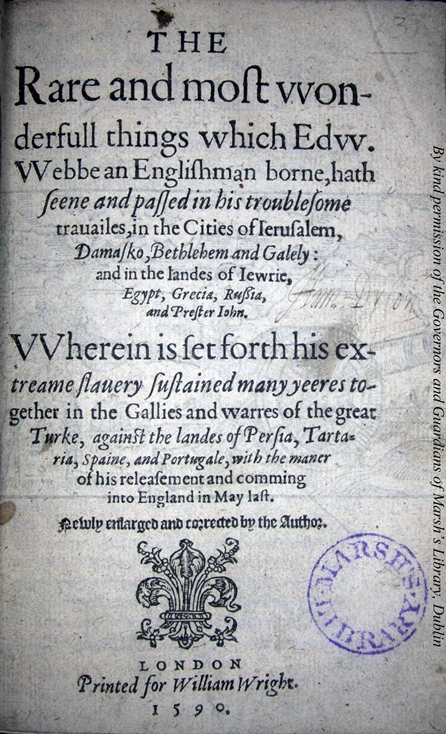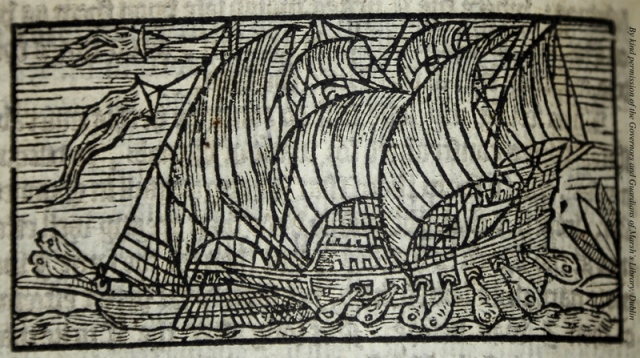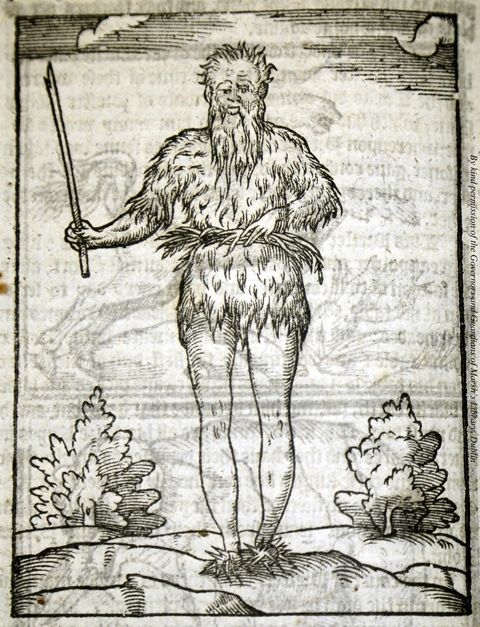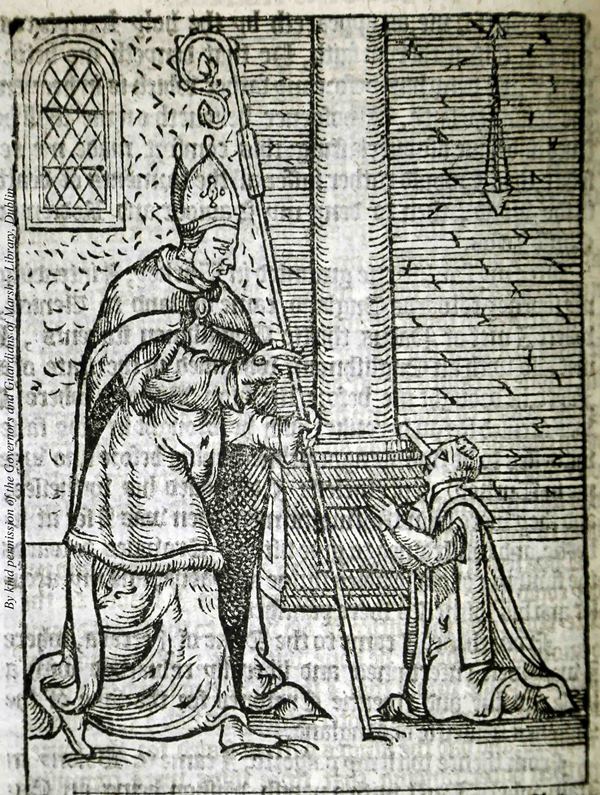Edward Webbe's The rare and most wonderfull things which Edw. Webbe an Englishman borne, hath seene and passed in his troublesome travailes
By Dr Edel Semple, University College Cork

From its very titlepage, The rare and most wonderfull things which Edw. Webbe an Englishman borne, hath seene and passed in his troublesome travailes (1590) promises its reader much; a marvellous tale of exotic lands and hazardous peregrination, a personal account of years of exceptional suffering, a Christian’s experience of slavery at the hands of the Turks, and a happy ending in the form of freedom and a return to English shores. The assurance that this edition is “Newly enlarged and corrected by the Author” signals that the work has sold well – this edition is in fact the third within the year – and now “new and improved”, its appeal no doubt increased. However, if all this was not enough, a glance at the pamphlet’s series of eye-catching woodcuts can only have convinced a hesitant buyer to lay down their money.
These marketing efforts are also apparent in the two dedicatory epistles as Webbe works hard to forge an impression of himself as a loyal Englishman and to present his “discourse” as true. The first epistle is to “my gratious and renowned Soveraine, Elizabeth”, and it is part prayer, part explanation, and part appeal for preferment. Although Webbe was enslaved at the time of the Spanish Armada of 1588, and only returned to England several months after the failed invasion, he offers “humble thankes to almightie God” for the salvation of his monarch and nation. In fact, Webbe claims, having learned of the Queen’s just actions, strong faith, and care for her “poore distressed” subjects from one of his fellow captives, he was much comforted during his “grievous thraldom in Turkey”. Now returned to his beloved native land, Webbe “in all humblenesse” prostrates himself before his sovereign in hopes of some gainful employment that will be “profitable to [his] Prince and Countrey”. This epistle shows Webbe as at once anxious and astute; he is clearly self-conscious about his absence during England’s time of need, but so too is he determined that his reader sympathise with his predicament – all the time that his homeland enjoyed relative “peace and plenty” and even when it was threatened, he languished in a foreign prison. Webbe even goes so far as to point out that had he denied God or his queen and country, he would have enjoyed “great prosperity”. Writing on the “economy of slavery” and conversion in the seventeenth century, Daniel Vitkus notes: “by the 1620s, thousands of English subjects had “turned Turk,” joining the Muslim fold in North Africa and parts further east. Many went willingly; others joined because they were captured and conversion was advantageous.” With this context in mind, Webbe’s implicit message is clear; having chosen the harder path of refusing to convert to Islam or to fight on behalf of Spain, he is deserving of some succour.
In “The Epistle to the Reader”, Webbe’s concern is to affirm the veracity of “this booke”. While Webbe presents himself as lowly and “humble” – a word he repeats often in the address to Elizabeth – here he is more confident and assertive in his claim that this “short discourse” mentions nothing “but that which is of truth” and which he has seen himself. However, should any “foolish persons” have any doubts, Webbe insists that they confer with him or other travellers or merchants and they “shall be resolved that this is true”. Tantalisingly, Webbe promises his reader that he has more wondrous tales than what this text contains but he “cannot call [these] to remembrance” as his memory has suffered due to his “great and grievous troubles”. Such a claim, Jonathan Sell remarks, may be a strategy to enhance the authenticity of Webbe’s tales. Whereas the first epistle closes with a reminder that Webbe is Elizabeth’s “most humble subject”, here he signs off as “Your loving Country man”; despite his many years away, Webbe implies, he remains an Englishman.
Throughout the text proper, Webbe’s Troublesome Travailes is a blend of travelogue, captive narrative, and ethnography. Although written in London, its content traverses the early modern globe: between Webbe’s first voyage at age 14 to his writing of the pamphlet at the age of 36, he visits Russia, Tartaria, Italy, France, Greece, Turkey, Persia, Hormuz, the land of Prester John (perhaps in Africa, perhaps in Asia), Tunisia, Egypt, the Middle East including Jerusalem and Damascus, and India, to name just a few places. While the pamphlet certainly includes some fabrications and inaccuracies, and occasionally recycles a hackneyed myth, it offers a fascinating insight into the life of an ordinary Londoner and his extraordinary experiences in far-flung locations. The entry for Webbe in the Oxford Dictionary of National Biography describes him as a “soldier and adventurer” but this label fails to capture the sense of just how remarkable his “troublesome travailes” are; the pamphlet’s title-page does a better job using as it does words such as “Rare”, “most wonderfull”, and “extreame”.
Webbe’s account opens with some sparse details on his background (he was born the son of a master-gunner, near the Tower of London), but it seems his life did not really begin until his first voyage of which we learn much. At the age of 14, Webbe was placed in the service of Captain Anthony Jenkinson, ambassador to Russia. He travelled with Jenkinson to Russia in 1566 – the ambassador’s third visit – and lived for three years in Moscow. Taken prisoner by the Crimean Tartars during the 1571 burning of Moscow, Webbe states that he spent five years as a slave at the king’s court in Caffa on the Black Sea. In recalling these experiences Webbe reflects on some of the characteristics, mores, habits, and laws of the Russians (“a kinde of tyrannous people”) and Tartarians which he witnessed. For instance, for offending the Emperor of Russia a man and his entire family would be thrown one by one into an icy river and, with no heirs, the offender’s wealth would pass to the Emperor. Webbe’s “miserable servitude” only ended when he was ransomed, at which point he returned to England for a short while.

On a later voyage, while returning from Alexandria to Livorno, Webbe’s ship, “the Henrie of London”, “met with fiftie saile of Turkes Gallies”. Now a master-gunner, and so in charge of artillery and ammunition, Webbe must have played a vital role in the ensuing clash. A small woodcut depicts part of this two-day battle: two ships engage one another at close quarters, the foreground ship’s cannons ablaze. Although the Henry inflicted great losses on its enemies, of its sixty sailors only ten survived the battle, Webbe among them. Taken to Constantinople, Webbe spent a further five years as a slave on a galley. The abuse (daily beatings), loss of agency (the slaves were shaven, given new clothes, and were chained to the ship), poor diet (black food, dirty water), hard labour, and ill-health that he and the other slaves suffered appears to be typical of the experience of galley slaves of the time. Webbe is at pains to note that it was only due to hunger that he eventually reveals his skill-set to his captors: “I was constrained for want of victuals”. With his usefulness confirmed, Webbe was selected to join the Turkish army in its wars against Persia. Although a step up from galley slave, this new role was not without its hazards: Webbe reports that on the march into Persia, 300,000 men died from disease, malnutrition, and starvation, and of the remaining 400,000, 60,000 died in the first “fierce assault” against the Persians.
Leaving Damascus behind, Webbe then journeyed to Cairo, “the greatest Citie in the world”. In his comments on Cairo, it is evident that Webbe was impressed by the city’s size, military power, and irrigation system. With the Turkish army, Webbe travels to Jerusalem where he sees “rare and most wonderfull things” before going to Agowa, “the chiefe Citie in all the East Indies” (now Goa, India). Here, the Turkish army battled the Portuguese but suffers terrible losses and fails to win the city. Returning to Damascus, Webbe was sent to apply his skills in the “warres against the land of prester John”. Stories of Prester John, a mythical but powerful Christian monarch, had circulated in travelogues since the early Middle Ages and had been popularised by works such as the 14th century The Book of John Mandeville. In his biography of Webbe in the Oxford Dictionary of National Biography, Raiswell remarks that: “Given the rest of [Webbe’s] itinerary, it is not likely that this was Ethiopia, the site more usually associated with this semi-legendary potentate in the sixteenth century.”

However, it is clear that Webbe relishes the task of describing the magnificence of Prester John’s court and the strange sights in his country. Webbe writes of the customs, political relations, and strange creatures that he witnessed. Three woodcuts are included; the first depicts a bearded “wilde man”, and we learn that one of these men can be found in Prester John’s court and another can be found in Constantinople. The text explains that this savage man is a public spectacle; chained by the neck, he is covered in hair, wears a mantle, and eats the flesh of condemned criminals. The other two woodcuts show a unicorn rampant and an elephant (“three score and seventeen Unicornes and Oliphants” live as tame pets in a park of Prester John’s.) Other texts on Asia and the Middle East may have influenced Webbe’s account of this ruler and his exotic land. For instance, his account of the sixty kings that daily serve Prester John is reminiscent of the multiple tributary kings that serve Bajazeth and Tamburlaine in Marlowe’s play (c.1587); the use of skulls as culinary utensils appears in Solinus’s Polyhistor (1584); while accounts of strange beasts, ‘wild men’, and cannibals were not uncommon and appear in Solinus and in Pliny (1585).
At this point, Webbe’s account begins to shift across time and between geographical locations. He recalls his travels to the Red Sea (“where Moses made passage”) and to Jerusalem. In this city, he visited Christ’s sepulchre which “is as it were in a vault. And hath seven doors and seven roes of marble steps or stayers to go down into the same”. We gain a sense of Webbe’s occupational background as he notes that a loadstone lies within this white chapel, which “Marriners and Saylers do use” for navigation. Webbe’s opinions also seep into the narrative when he discusses the mass that is said daily before Christ’s tomb. According to custom, only a virgin man could say this mass and, while Webbe was visiting Jerusalem, a 130 year old man who said this mass died. Webbe seems to accept the priest’s longevity, but the notion of male abstinence comes in for some scepticism: “but whether the old man … [or other priests] were pure virgins I know-not, but sure I dare not swere for them, because they are men, and flesh and bloud as other are.”
After lengthy travels and service, Webbe was eventually returned to prison in Constantinople, where he languished along with 2,000 other Christians. The hardships of “this slavish life” spurred Webbe to lead a prison break. Caught in the attempt, he and his fellow captives were viciously beaten, suffering “seven hundredth blowes a piece with a bulls pissell upon the naked skinne”. As Jonathan Sell notes, “What most impresses the reader who toils through Webbe’s Troublesome Travails is precisely the damage the world he travelled through inflicted upon his body”. In 1588, through the intercession of the English ambassador William Harborne, and with a ransom gathered from London’s citizens, Webbe and “sundry other English captives” were “set free from thraldome”. Before Webbe embarks on the final portion of his tale – his return to England via Italy – he takes time to remind the reader of his steadfast Christian faith. Although the Turk “by all meanes possible would still perswade me … to forsake Christ”, and despite the rewards attendant upon conversion, Webbe resisted and kept to the true faith.

Webbe made his way home by travelling through Italy from Venice, to Padua, Ferrara, Bologna, Florence, Rome and finally Naples. This journey was not without its adventures and troubles. Webbe came under suspicion as a heretic in Padua, was examined and eventually blessed by the pope in Rome (a woodcut shows this moment), was taken and dressed as a fool in the English College, and finally, taken as a spy in Naples, he was held and tortured for seven months. When his captors “coulde finde no cause against [him]”, Webbe was released to work as a gunner but soon fled to London “with great joy and harts delight”. One final comment from Webbe on his journey through Italy highlights the variety of difficulties that travellers could encounter. Far from home, and in a hostile (in this case, Catholic) land, accurate news was hard to come by and disinformation could be used as a psychological weapon. Travelling through Italy, Webbe tells us, the people taunted him with tales of the Spanish Armada’s success; Elizabeth was “coming towards Rome to doe penuance” and her captors persecuted her by travelling through “foule places” where she “might have gone up to the mid legge in oes [ooze] or mire”. This indecorous image of his queen, subjugated and shamed, failed to shake Webbe and he notes how he responded to such taunts by placing his faith in God.
Despites years of slavery, and the lengthy and various hardships Webbe suffered, he did not linger long in London. The concluding portion of Troublesome Travailes relates how Webbe “departed into Fraunce” to fight for Henri of Navarre (later, Henri IV) in the French Wars of Religion. Webbe’s fighting against the “Traitorous Leagers” and his disgust at their “extreame tyranny” acts as a demonstration of his Protestant faith. Moreover, in his battle against the Catholic League, Henri of Navarre was viewed as something of a Protestant hero and was a source of much interest in London and at court in the late 1580s. Thus, in linking himself with Henri and his success at the Battle of Ivry (14th March 1590) – a victory in which English support was instrumental – Webbe capitalises on the popularity of this champion of the true religion and further bolsters his own national and religious identity.
In the final lines of Troublesome Travailes Webbe reminds his reader of his aims in writing: “I shall be glad, and do daily desire that I may be imployed in some such service as may be profitable to my Prince and Countrie”. Closing its account of Webbe, the Oxford Dictionary of National Biography records that, early in 1592, “Webbe was made a cannonier for life, receiving a fee of 10s. per diem. Nothing further is known of his life.” While Webbe may have disappeared from the records after 1592, his account of his adventures and misfortunes, both real and imagined, over two decades is certainly memorable and merits further attention. Troublesome Travailes is reprinted in Edward Arber’s ‘English Reprints’ (London: Alex Murray and Son, 1868) and much of the text appears, with editorial notes, in Parker’s Early Modern Tales of Orient: A Critical Anthology.
To access the catalogue entry for Webbe's The rare and most wonderfull things...click here.
Bibliography:
- Davis, Robert C. “Counting Slaves on the Barbary Coast,” Past & Present, 172 (2001): 87-124.
- Parker, Kenneth, ed. Early Modern Tales of Orient: A Critical Anthology. London: Routledge, 1999.
- Raiswell, Richard. “Webbe, Edward (b. 1553/4), soldier and adventurer.” Oxford Dictionary of National Biography. Oxford: Oxford University Press, 2004.
- Sell, Jonathan P. A. Rhetoric and Wonder in English Travel Writing, 1560-1613. Farnham, Surrey: Ashgate, 2006.
- Stanivukovic, Goran, ed. Remapping the Mediterranean World in Early Modern English Writings. New York: Palgrave, 2007.
- Vitkus, Daniel J., ed. Piracy, Slavery, and Redemption: Barbary Captivity Narratives from Early Modern England. New York: Columbia University Press, 2001.
- Vitkus, Daniel. “Adventuring Heroes in the Mediterranean: Mapping the Boundaries of Anglo-Islamic Exchange on the Early Modern Stage”. Journal of Medieval and Early Modern Studies, 37:1 (2007): 75-95.